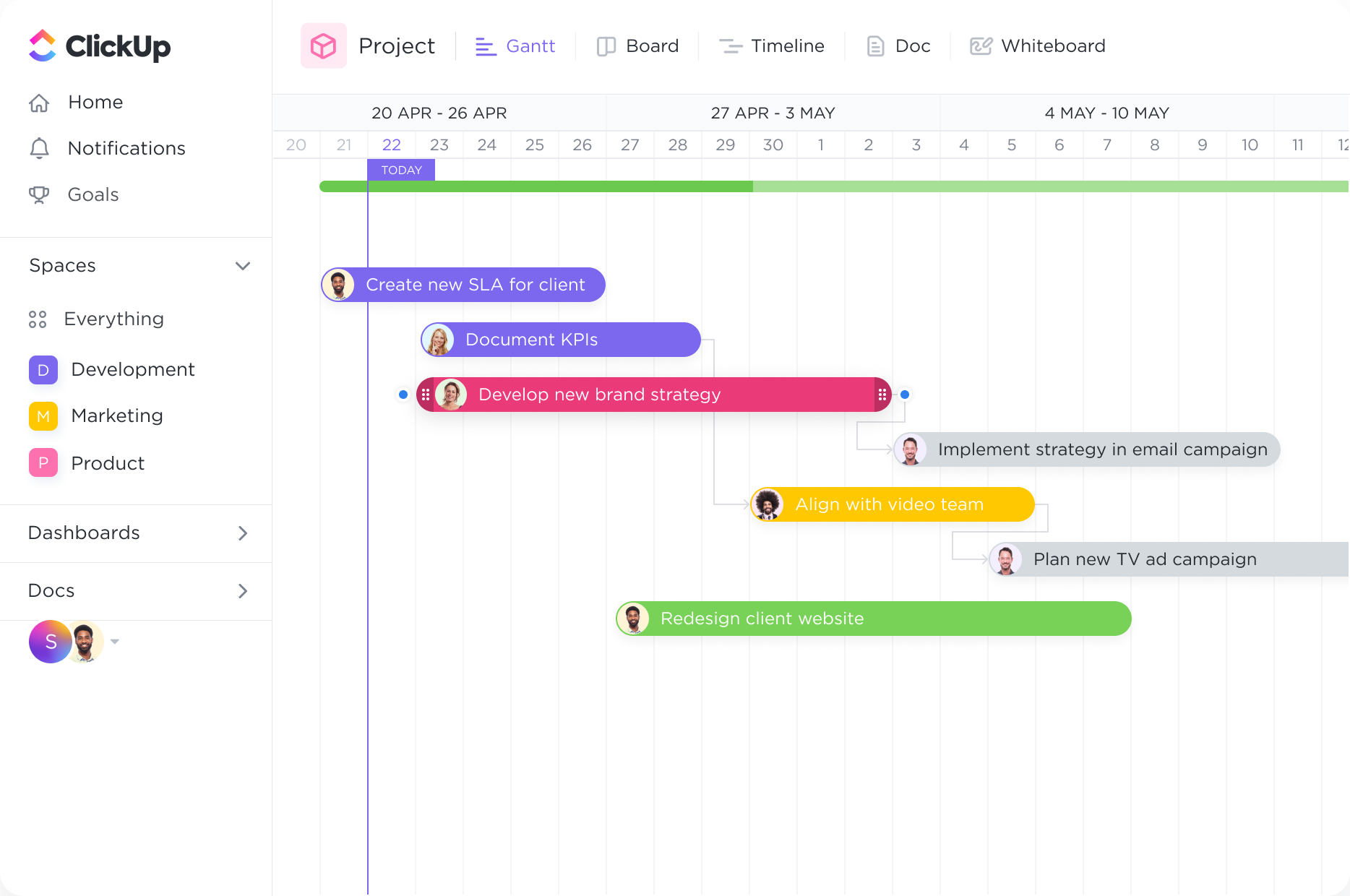Dependencies
Set task dependencies.
Create tasks and link them with dependencies. Dragging a task with dependencies will automatically reschedule tasks in the chain
Gantt Charts
Create dynamic Gantt Charts with ClickUp, the ultimate scheduling tool. Effortlessly plan and organize your projects with the power of ClickUp's intuitive features. Visualize task dependencies, track progress, and allocate resources seamlessly. Take control of your schedule and boost productivity with ClickUp's Gantt Chart software.
Free forever. No credit card.

Dependencies
Create tasks and link them with dependencies. Dragging a task with dependencies will automatically reschedule tasks in the chain
Tracking
Intelligent dependency-path tracking shows you where potential bottlenecks might exist to prevent inefficiencies.
Gantt charts are widely used in project management and planning. They provide a visual representation of project timelines, deadlines, and milestones, allowing project managers to effectively plan and allocate resources. By using Gantt charts in schedulers, project managers can easily track the progress of tasks, identify dependencies, and make adjustments to keep the project on track.
In a team environment, Gantt charts can be used to allocate tasks among team members and track progress collectively. By visualizing task assignments and timelines, team members can easily see their responsibilities and deadlines. This promotes collaboration, accountability, and transparency within the team, ensuring that everyone is working towards the same goals.
Efficient resource allocation is crucial for maximizing productivity and minimizing costs. Gantt charts can be used in schedulers to manage and optimize the use of resources such as personnel and equipment. By clearly visualizing resource availability and utilization, project managers can make informed decisions about resource allocation, ensuring that resources are utilized effectively and efficiently.
Meeting deadlines is essential for project success. Gantt charts in schedulers allow project managers to track and monitor deadlines in real-time. By visualizing deadlines alongside tasks and milestones, project managers can easily identify potential delays and take proactive measures to keep the project on schedule. This helps to ensure that projects are completed on time and within budget.
Gantt charts can be used as a powerful communication tool for reporting project progress. By sharing Gantt charts with stakeholders, project managers can provide a clear overview of project status, tasks completed, and upcoming milestones. This promotes effective communication, transparency, and alignment among team members and stakeholders, fostering a collaborative and productive work environment.
Every project involves risks and uncertainties. Gantt charts in schedulers can be used to identify potential risks and develop contingency plans. By visualizing critical paths, dependencies, and milestones, project managers can assess the impact of potential risks on the project timeline and make proactive decisions to mitigate them. This helps to ensure that projects stay on track even in the face of unexpected challenges.
A Gantt chart can display multiple tasks, activities, and milestones in a clear and structured manner, making it easier for schedulers to understand and communicate the overall schedule.
A Gantt chart can show the dependencies and relationships between different tasks, allowing schedulers to identify critical paths and ensure that tasks are scheduled in the correct order.
A Gantt chart can provide a visual representation of resource availability and allocation, helping schedulers ensure that resources are assigned efficiently and that there is no overallocation or underutilization.
With a Gantt chart, schedulers can easily identify conflicts such as overlapping tasks or resource constraints and make adjustments to the schedule to resolve these conflicts.
A Gantt chart can be used to track the progress of tasks and update the schedule in real-time, allowing schedulers to keep stakeholders informed about any changes or delays.
By analyzing the Gantt chart, schedulers can identify opportunities to optimize the schedule, such as adjusting task durations, reassigning resources, or changing task dependencies.
Gantt chart software allows you to visually plan and schedule tasks, track progress, and manage dependencies in a project. You can use it to assign resources, set task durations, and establish deadlines. By updating the Gantt chart in real-time, you can monitor project timelines, identify potential delays, and make adjustments as needed. This enhances project coordination, communication, and overall efficiency, ensuring that tasks are completed on time and within budget.
Gantt chart software provides schedulers with key features and functionalities such as visual timeline representation, task dependencies, resource allocation, progress tracking, and milestone tracking. It enables schedulers to effectively plan, schedule, and manage projects, ensuring efficient resource utilization and timely completion of tasks.
Yes, there are several best practices and tips for using Gantt chart software to optimize scheduling efficiency and accuracy. These include: </p>